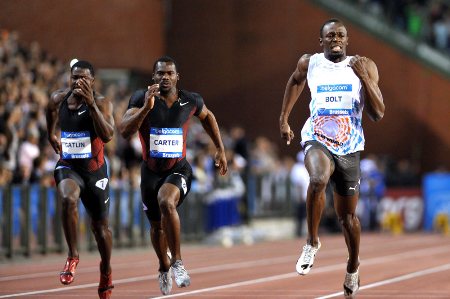On 16 September, Usain Bolt, the Olympic sprint champion, finished the 100 m sprint event held at the Van Damme Memorial in 9.76 s.
Researchers belonging to K.U.Leuven’s Faculty of Kinesiology and Rehabilitation Science used sophisticated laser technology for measuring and analyzing the sprinter’s speed. The analyzed data will help improve the training methodologies for other sprinters.
 K.U.Leuven team uses laser technology to analyse Usain Bolt’s speed at Van Damme Memorial
K.U.Leuven team uses laser technology to analyse Usain Bolt’s speed at Van Damme Memorial
In the year 2009, in Berlin, Usain Bolt had finished a 100 m sprint in 9.58 s, a world-record. Applying laser technology the K.U.Leuven team analyzed and compared the athlete’s performance in both the races. They measured the speed of the sprint 300 times per second. In the Memorial sprint in Brussels, Bolt finished the sprint in 9.76 s, with a speed of 21.4 km/h within the first four strides which was equivalent to 5 m. He achieved a top speed of 12.22 m/s or 43.99 km/h after running for a distance of 67.13 m. In the Berlin race Usain Bolt’s top speed was 44.5 km/h and he reached a speed of 25 km/h within the first 5 m. In the first 75 m and in the last 10 m, the sprinter was faster by 0.5 km/h in Berlin when compared to his performance in Brussels. However, his phase-by-phase scores did not go down in the Brussels race.
The analysis revealed Bolt’s only ‘weak point,’ his start, may be due to his long body. But he scored high in all phases, while previous top sprinters such as Carl Lewis and Ben Johnson performed splendidly in certain phases.
Yohan Blake, the new sprint sensation, finished the 200 m race at the Memorial in 19.26 s, slightly longer than Bolt’s record. He had a bad start and he is not tall. The research also revealed that the length of legs is not the criteria for achieving high speeds. It showed the need of detailed phase by phase analysis of a sprinter’s race for analyzing the differences.
The K.U.Leuven research team is using lasers to measure sprinters’ performance in all phases of the race. It is performing the study in training centres in the Netherlands, South Africa and China.